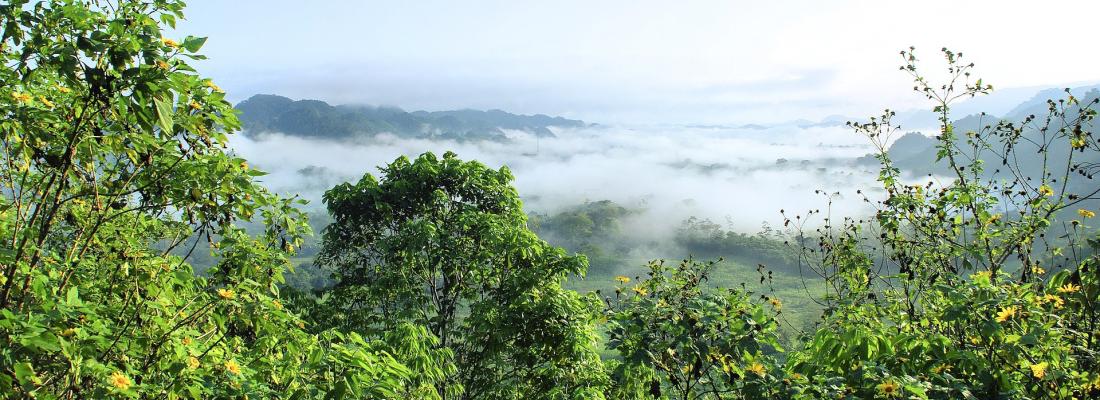Climate change and risks Reading time 4 min
Satellite mapping of changes in forest carbon sequestration
Published on 29 October 2021

Today marks the launch of the Biomass Carbon Monitor, the first geospatial platform that measures the role of forests in carbon capture through changes in biomass. Kayrros, in collaboration with the French National Research Institute for Agriculture, Food and Environment (INRAE) and the French Laboratory of Climate and Environmental Sciences (LSCE), have built this tool based on 30 years of research and are today providing open access to the Biomass Carbon Monitor.
The Biomass Carbon Monitor provides publicly accessible and comprehensive global maps of changes in carbon stocks held in above-ground biomass. The data make it possible to quantify annual biomass changes and calculate the role played by forests in reducing carbon.
The Monitor’s systematic measurements of microwave emissions are derived from the European Space Agency (ESA) SMOS satellite and combined with advanced algorithms. The overall findings show carbon gains in northern forests and losses in tropical regions more affected by deforestation. Globally, 760[1] [2] million tons (Mt) of carbon were removed from the atmosphere each year over the last decade – offsetting around 8% of CO2 emissions from fossil fuel burning and cement production over the same period.
Other key findings include:
- A substantial carbon sink is visible in Southeast China (Yunnan, Sichuan, Chongqing, Guizhou, Guangxi and Guangdong, including Hong Kong and Macau) representing an annual 80 Mt carbon gain over the last ten years. This is thought to be the result of regrowing vegetation due to afforestation and restoration programmes, improved forestry practices and decreased pressure on local forests and woodlands.
- Tree growth in the western Russian districts of Central Federal, North Caucasian Federal, Northwestern Federal, Southern Federal and Volga Federal captured an additional 100 Mt of carbon per year from 2011 to 2020, more than all EU forests combined. Farmland abandonment as well as warmer spring temperatures may have favoured rapid vegetation growth in this area.
- In the Americas – the Northeast, Midwest and Southeast regions of the US and the Caribbean – above-ground biomass also increased and removed an average of 93 Mt per year from the atmosphere over the last decade.
- In the Tropics, deforestation though the replacement of carbon-rich primary forests by plantations and forest degradations is a key driver of observed changes over the last decade. Brazil (loss: 40 Mt per year), Bolivia (loss: 20 Mt per year) are hotspots of carbon loss due to decreased vegetation, while the Congo basin (gain: 45 Mt per year) and Southeast Asia[3] (gain: 30 Mt per year) remain carbon sinks.
The Biomass Carbon Monitor provides data going back to 2011 and will be updated on a quarterly basis. The data will provide governments, forest managers, conservation agencies and citizens with science-based information to continuously track changes in forest-based carbon stocks and assess the carbon losses from extreme climate events in near-real time.
It is widely known that forests and vegetation play a major role in removing CO2 from the atmosphere. The Biomass Carbon Monitor now presents previously unavailable information about regional biomass carbon changes, which can be used as a sort of balance sheet to track net gains and losses from forest policies.
“Nature-based solutions have a key role to play in combating climate change, but only if we can keep track of how much carbon emissions they are actually offsetting and where,” said Antoine Rostand, Kayrros President. “With this independently measured balance sheet, countries will be able to move to a market value for increases in biomass in their territory. Moving from 5 USD per ton of carbon to the Emissions Trading System price, policymakers will be in a position to manage their biomass and provide the right incentives to farmers and landowners."
"This is a revolutionary tool that complements existing inventories and space observations with comprehensive information on how biomass carbon stocks are changing over time,” said Philippe Ciais, Research Director at the LSCE, which co-initiated this project.
“This data, combined with information on the drivers of biomass variations such as fires, land use change, forest management and regional climate trends, will provide the scientific community and decision-makers with brand new insights and resources about the dynamic of carbon in forests,” concludes Jean-Pierre Wigneron, Research Director at INRAE, who created the Vegetation Optical Depth (VOD) datasets used to quantify biomass carbon change.
[1] Figures are given for the above-ground biomass which doesn’t include the soil and the roots. Estimates show that below-ground biomass accounts for around one third of total carbon volume sequestered by biomass. Therefore, if both above-ground and below-ground biomass are accounted for, the global sink would be around 1,100 Mt of carbon per year.
[2] The uncertainties on the carbon stocks changes are on the order of 25% (Fan et al., Nature Plants 2019); all details on the estimation method and the associated scientific publications are described on the website. https://carbonstocks.kayrros.com/.
[3] Southeast Asia here defined as Vietnam, Laos, Cambodia, Thailand, Indonesia, Singapore, Malaysia, Brunei, East Timor and the Philippines.
